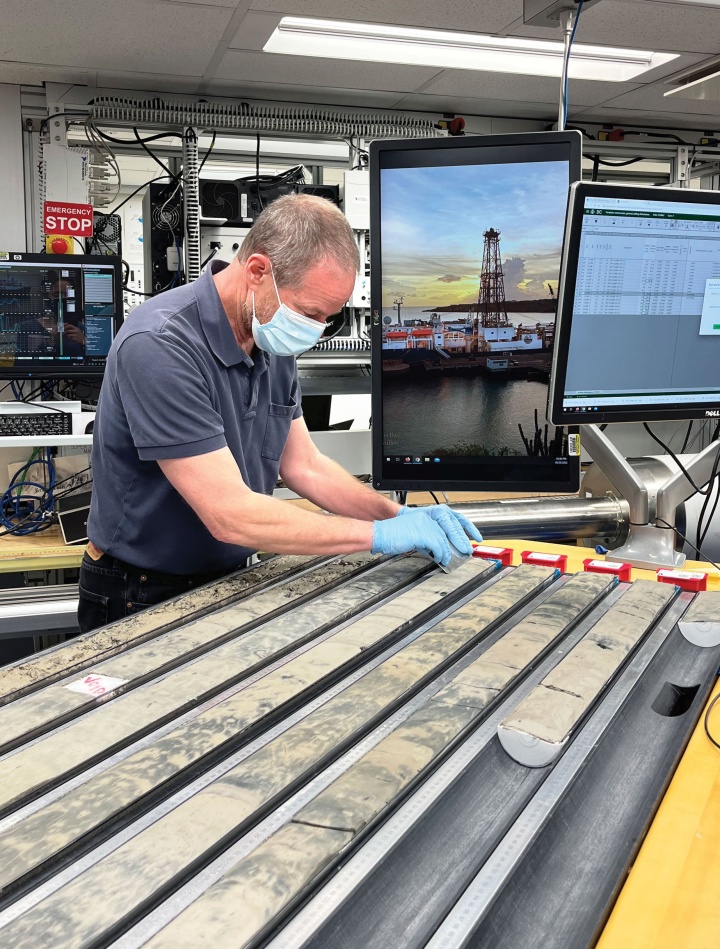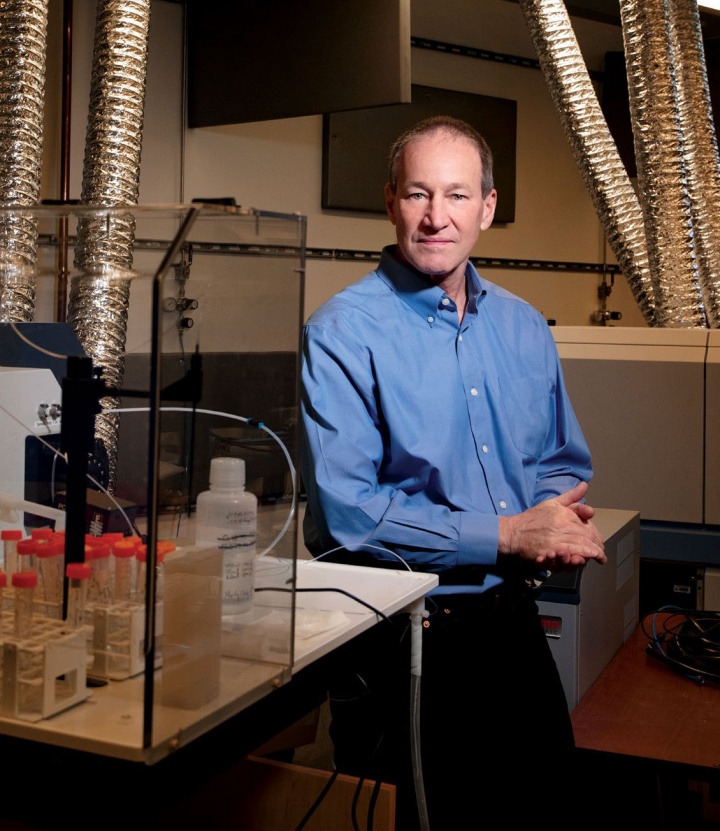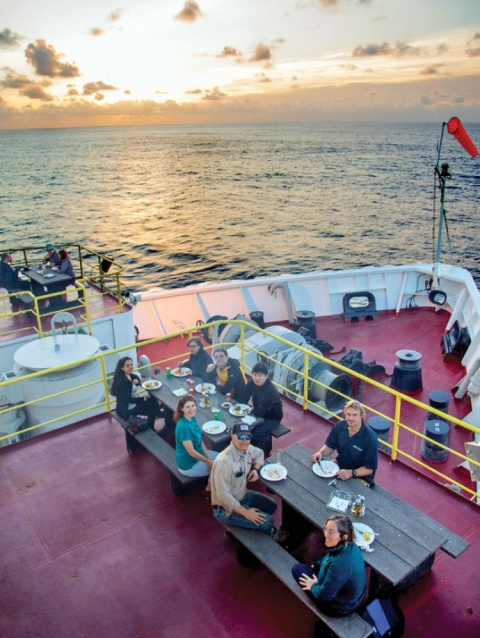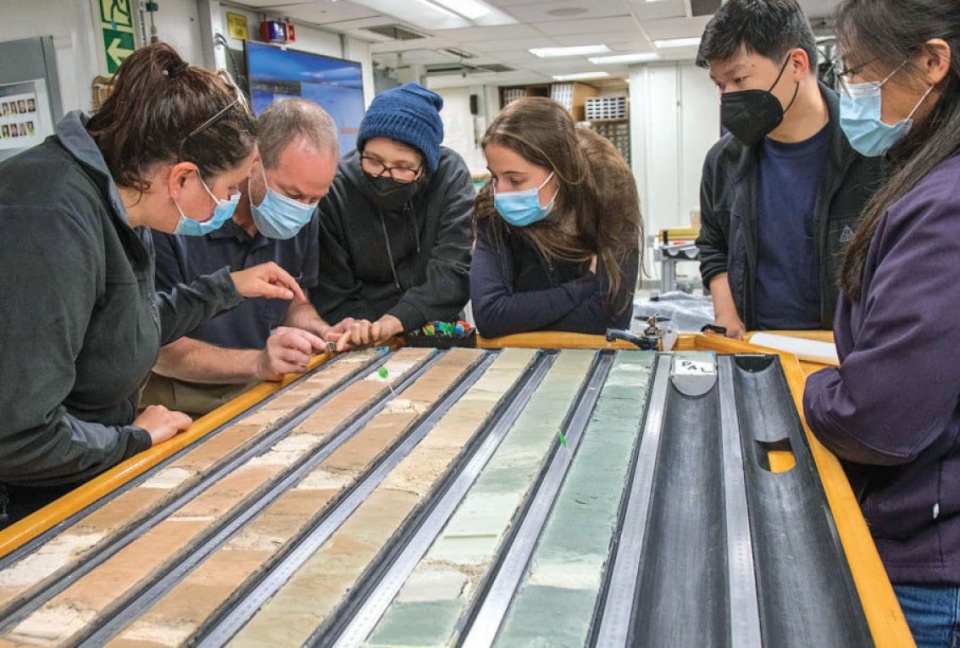Jerry McManus ’89, GSAS’97 is looking for answers to climate change at the bottom of the ocean.
Columbia College | Columbia University in the City of New York
Jerry McManus ’89, GSAS’97 is looking for answers to climate change at the bottom of the ocean.

Aboard the JOIDES Resolution this past fall, Jerry McManus ’89 removes veneer from a newly opened core to reveal sedimentary structure and colors; the latter begin to fade immediately upon exposure to air.
CELESTE PALLONE BC’19, GSAS’24
This wasn’t just any mud, though. It was sediment deposited over millions of years and with a story to tell. As a paleoceanographer, McManus — chair of Columbia’s Department of Earth and Environmental Sciences — studies the ancient ocean, in particular its relationship with the climate over timescales both long (millions of years) and short (thousands).
McManus was one of about two dozen scientists aboard the JOIDES Resolution, a 470-foot scientific drilling ship that travels the world as part of the International Ocean Discovery Program (IODP). (JOIDES stands for Joint Oceanographic Institutions for Deep Earth Sampling.) At select locations, the ship drills into the seafloor, pulling up cores — cylinders of soft sediment 10 meters long and a few inches in diameter. Once on board, the samples are sliced in half lengthwise and placed on tables for scientists to inspect for clues about what happened long ago. At a given spot, the drill can retrieve core after core, going a kilometer or more under the seafloor.
The researchers who joined this particular expedition — officially, IODP number 397 — were there to collect samples that will complete an archive of sediment going back three to five million years, through the geologic periods known as the Quaternary and the Pliocene. From that raw data, they will eventually be able to reconstruct the natural variability of the North Atlantic climate, which is to say, how the weather worked before humans came along to leave their mark. McManus is especially interested in the ocean’s storage of carbon (it holds 50 times more than the atmosphere) as well as “the dynamics of how the ocean moves heat around our planet.”
“The overarching question in my mind is: Does the ocean affect climate change on a wide spectrum of timescales?” McManus says. “And then within that, there are many specific questions: How fast does climate change? How fast does the ocean respond to that? What is the role of the ocean in heat transport? What’s the ocean’s role in storing carbon?” Answering these questions could shed light on climate change, but more fundamentally teach us about an evolving Earth.

Jörg Meyer
McManus owes his career in part to the late Wallace S. “Wally” Broecker ’53, GSAS’58, a giant in geochemistry. McManus took a couple of his courses at the College, “and it opened my eyes to thinking about how Earth’s climate system varied through time, and how the record of that was captured in the sedimentary and rock record of the earth,” he says. Still, he recalls that Broecker was unimpressed by him. “He described me in his old-style language as a ‘ne’er do well.’” McManus later did his Ph.D. with Broecker. “I told him, ‘Ne’er say ne’er.’”
He credits Broecker for another awakening. “At one point, he told me, ‘Someone like you can go to graduate school for free and get paid,’” McManus says. “And for a kid from the Bronx, this was a revelation. I didn’t know that such a world existed. That wasn’t about scientific inspiration. It was more about the realm of the possible in one’s life.”
Graduate school was not the next step, however. Instead, McManus spent a few years interning at a German optics company. He provided technical support to researchers who used its image-analysis equipment; then they’d continue with their project while he moved on to the next assignment. “And I got to thinking that I was on the wrong side of that interaction,” McManus says. He returned to New York with the aim of going back to school and took a job at the American Museum of Natural History as he worked on applications.
McManus says he chose Columbia’s Lamont-Doherty Earth Observatory over other renowned options such as the Woods Hole Oceanographic Institution and the Scripps Institute of Oceanography because it “was very strong in looking at the modern climate in the context of how Earth’s climate has evolved through time. And those aspects trumped the appeal of oceanographic institutions for me.”
For his dissertation, McManus researched the last time that planetary temperatures were as warm as today — a period between ice ages that occurred about 120,000 years ago. He looked at seafloor fossils of single-celled organisms called foraminifera that live near the ocean’s surface. Many foraminifera species have environmental preferences; McManus studied one that thrives in cold water. “Just using that one indicator, looking at how its relative abundance came and went at multiple locations in the North Atlantic, we could reconstruct patterns of climate change,” he says.
McManus went to Woods Hole as a postdoctoral investigator before taking a job and staying for a decade. He taught some MIT students there, “but I kind of missed the intellectual diversity of a university,” he says, “and I was interested in getting involved in undergraduate education.” So he was happy when Columbia recruited him, and he returned to Lamont in 2008.
The Lamont-Doherty Earth Observatory, founded in 1949, sits on a donated family estate of 189 acres about 15 miles north of Manhattan. It’s home to hundreds of researchers studying land, ocean and air. It also houses the Lamont-Doherty Core Repository, a collection of 20,000 seafloor samples, where I received a tour before Mc- Manus headed to Portugal. Large rooms hold racks of narrow 1.5-meter-long trays of dried sediment collected since the 1950s. For years, two ships, the Vema and the Robert Conrad, traveled the globe taking samples daily. Unlike the JOIDES Resolution, they’d lower a metal tube overboard, then use a piston to shoot it into the seafloor muck and pull up whatever it captured.
The Core Repository is not just a warehouse but also an active research center for scientists at Columbia and elsewhere. Each core is “this limited resource that brings the community together,” says Brendan Reilly, head of the repository. “There’s this core from this one location that we think is useful, then you get many people together working on it. Anyone with a valid scientific question is allowed to come here.”

A barbecue meal was a weekly affair aboard the JOIDES.
Carlos Alvarez
McManus and Celeste Pallone BC’19, GSAS’24, a graduate student who would accompany him on the cruise, took over the tour. Foraminifera shells are still central to McManus’ work, and, upstairs from the Core Repository, they bring me to a microscopy lab where researchers use paintbrush bristles to place the grain-of-sand-sized shells under lenses.
Afterward, we walk to the shiny geochemistry building, completed just before McManus arrived as faculty and home to dozens of labs and offices. One room contains two large mass spectrometers, named Wallace and Gromit, that can differentiate not only elements from the cores but also isotopes. In a nearby clean room, staff must wear protective clothing to do their work of purifying samples. As Pallone heads back to Manhattan, McManus and I go to his office to discuss his upcoming trip.
The cruise’s destination off Portugal is called the Shackleton site, after the late Sir Nicholas Shackleton, a paleoclimatologist who discovered that cores from the area could be aligned with ice cores from Greenland and Antarctica, allowing scientists to piece together global timelines for climate change. That’s in part because waters from the north and south mix in the area, and in part because sediment collects there copiously, allowing for high-resolution study of its layers. Ice cores in Greenland and Antarctica go back only about 120,000 and 800,000 years, respectively, so alignment with those cores means researchers can use deeper sediment layers to infer what happened near the poles before that time. “Nick Shackleton did something really beautiful to align the North Atlantic with Antarctica,” McManus says.
McManus has been on about 10 sampling cruises, to the Pacific, Antarctic and North Atlantic, spending more than a year of his life total at sea.
On the cruise, scientists took turns working 12-hour shifts, running initial analyses on the cores as they were brought onboard. Specialists looked at the samples’ physical, acoustic or magnetic properties, or described their foraminifera. They drafted a report of the findings while still on the ship.
The data will, in part, help them explain short-term changes in the atmosphere that happened on a scale of 1,000 years or so, what’s known as millennial climate variability. Many scientists point to the so-called Atlantic meridional overturning circulation (AMOC), a focus of McManus’ work, as the reason for this variability. In his office at Lamont, he draws a diagram on the whiteboard: Picture a conveyor belt. Warm water in the Atlantic flows northward, where it cools and sinks, then spreads southward, where it eventually rises again. Changes in this circulation can affect global climate. Scientists worry that Greenland’s melting glaciers could slow or halt the process.

Scientists from France, Germany, China and the United States begin initial examination of a surprisingly colorful core recovered at the expedition’s first drilling site.
Carlos Alvarez
McManus has been on about 10 sampling cruises, to the Pacific and Antarctic as well as the North Atlantic, spending more than a year of his life total at sea. He could theoretically have stayed at home and waited for core samples to come to him. But “the participants on the ship will have the first crack at it,” he says. Beyond that, “I can contribute by being a more experienced voice and helping some of the junior scientists.”
Kassandra Costa GSAS’18, a paleoceanographer at Woods Hole who earned her Ph.D. in McManus’ lab and still collaborates with him, appreciated his guidance. While being supportive, he allowed freedom. “He gave me a project and then I sort of ran with it.” As for his scientific style, Pallone says, “if he’s exploring a hypothesis, he rules out every other possibility. He’s encouraged me to be really sure about the claims that I’m making.”
Anderson was a faculty member at Columbia when McManus was a student. “What I remember most is that he was fun to be around,” Anderson says. “Whether talking about science in the lab, or when we used to play on the same basketball team. He was actually pretty aggressive on the basketball court.” Anderson rethinks the word aggressive. “He pushes all the time. In everything, not just his research. Whether it’s playing a sport or working on something. And also with his students.”
Aside from ocean sediments, there’s another kind of core that’s important to McManus: the Core Curriculum. It didn’t make him a scientist, he says, but “I did like the idea of learning about different aspects of civilization and culture and knowledge.” He passes on the tradition. “Some- times threads spring up that I remember from the Core, and I torture my students with them when they think they’re there to learn about the ocean or the climate.”
Humans, for better or worse, are now an integral part of the climate. “I spend all my time thinking about what happened in the past at this location at this time,” McManus says, “but I don’t forget that there’s this bigger realm of the whole Earth and the life that it supports and the human role in that.”
Matthew Hutson is a freelance science writer in New York City and a contributing writer at The New Yorker.

Published three times a year by Columbia College for alumni, students, faculty, parents and friends.
Columbia Alumni Center
622 W. 113th St., MC 4530, 6th Fl.
New York, NY 10025
212-851-7852
cct@columbia.edu

Columbia Alumni Center
622 W. 113th St., MC 4530, 4th Fl.
New York, NY 10025
212-851-7488
ccalumni@columbia.edu